Shinkansen High Speed Passenger Rails
Developed during a time when other nations expected the demise of passenger rail service, the Japanese Shinkansen meets many of the passenger transportation of Japan.
by Bob Kerstetter
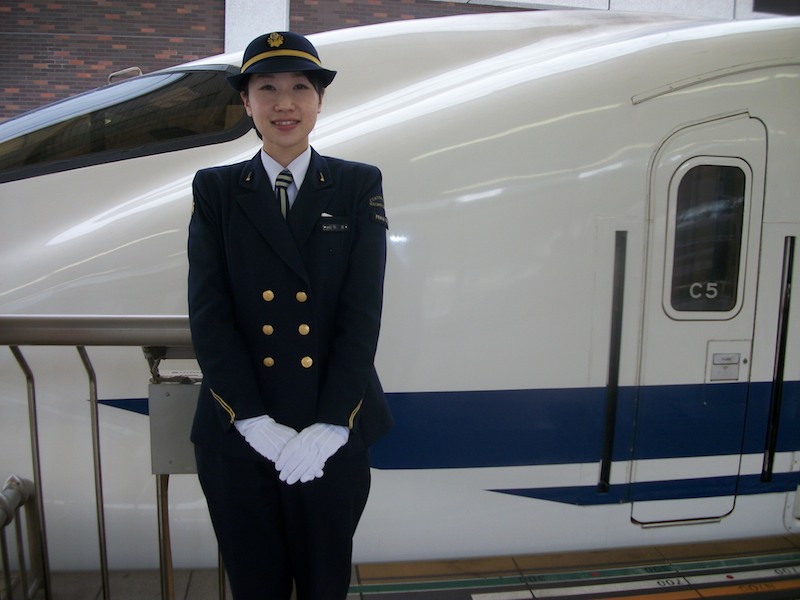
A female Shinkansen driver stands with the train she drove from Osaka-shin to Tokyo Station. Female Shinkansen drivers are somewhat rare, but increasing in number, according to our sources in Japan.
Clean Shinkansen Runs on Time
You soon learn to arrive on time—neither early nor late. You wait in line with a mix of dark-suited businessmen, older persons attired in soft colors, baby-filled strollers powered by exhausted parents and vacationers in a variety of apparel—from silk dresses and silver shoes to short-short jeans, black stockings and heels. Almost everyone is Japanese.
Women wearing identical pink pantsuits tote cleaning gear as they troop along the platform in two neat rows. Distributing themselves in pairs, they wait at attention on each side of the numbered squares marking train door locations.
Exactly on the minute of its scheduled arrival the Shinkansen glides into the station. Late times average approximately 36 seconds—even accounting for bad weather delays. A long tapered nose leads the way—stretching several meters in front of the curved glass panels of the driver cab. The shiny transporter silently pushes aside the last remnants of air resistance as it slows to a perfectly smooth stop.
When the doors open the pink-clad women bow slightly to each exiting passenger. Bowing again, they enter the empty cars then quickly clean them, rotate seats to the opposite direction, bow on exiting and promenade off the platform in two neat parallel rows.
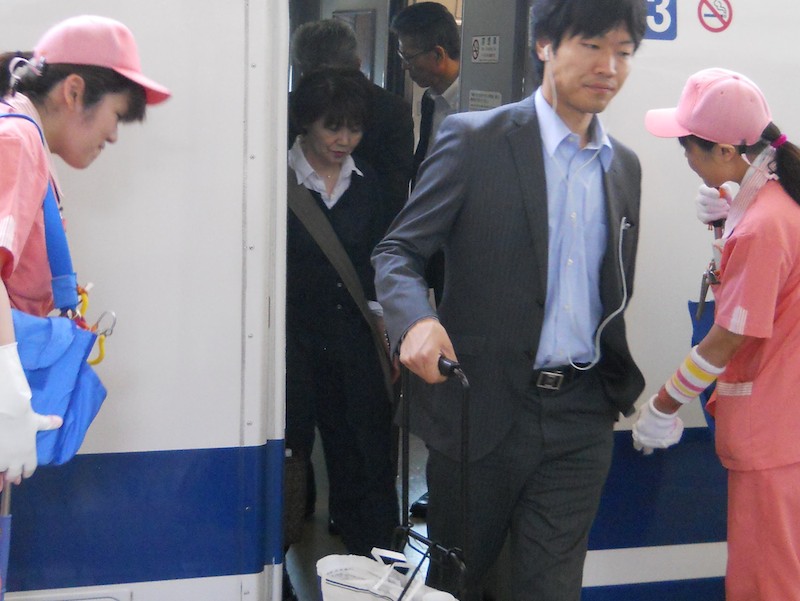
When the cleaners meet a Shinkansen at its terminus, they bow to the passengers exiting the train. They then quickly clean and prepare the Shinkansen for its next trip.
During the cleanup, the bullet train driver opens the cabin door and softly steps into the station. In appearance her years can total no more than 25-28 at the very most—although Japanese women often look much younger than their age. She holds a very unusual job in a male-dominated career. "A few women are becoming train drivers," a Japanese friend tells you.
Speeding Safe and Fast on Rails in an Air Travel Era
Shinkansen operation began during a time when other countries planned for the demise of passenger rail service. Increased air travel and personal automobiles would supposedly eliminate the desire for train travel. This theory apparently forgot about Japan. Shinkansen travel works in Japan because it moves huge numbers of individuals—more than 900,000 each day—between closely spaced cities in an efficient, safe and comfortable way.
The nationwide morning rush hour sees bullet trains leave urban stations as often as every six minutes. Each carries up to 1,300 riders. They travel to destinations from Aomori City in the east of Honshu to Kagoshima City in the south of Kyushu. Shinkansen stations service diverse cities—large, medium and small—including Morioka, Kitakami, Sendai, Niigata, Tokyo, Nagoya, Kyoto, Osaka, Okayama, Hiroshima and Hakata.
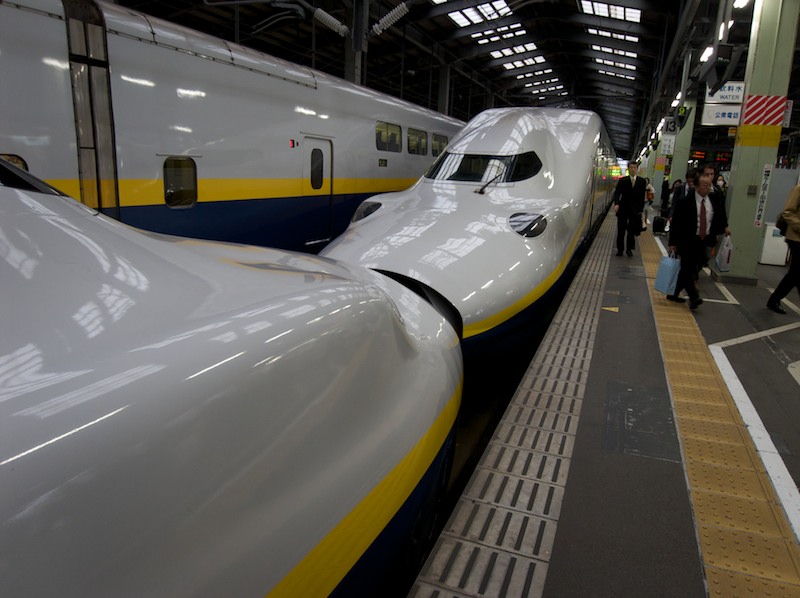
Shinkansen trains vary in length from eight to 16 cars. Some eight-car trains can join to form a longer train during high capacity hours. This is a double-deck Shinkansen running in eastern Japan between Tokyo and Niigata./p>
Shinkansen trains run flat and straight, avoiding steep slopes and tight curves—the enemies of efficiency and comfort. Slopes lead to inconsistent speeds. Curves create disagreeable centrifugal forces. Shinkansen tracks stay essentially uniform in elevation and direction by tunneling through mountains and bridging over valleys. By running on raised tracks they never encounter motor vehicle traffic.
Every passenger car—plus the driver cabs on each end—power the Shinkansen. Dozens of electric motors drive steel wheels along steel tracks at bullet train speeds. When the Shinkansen first ran between Tokyo and Osaka in 1964, its top speed reached 210 kilometers an hour—slightly more than 130 miles an hour. The fastest Shinkansen today travels up to 320 kilometers an hour—almost 199 miles an hour. Typical Shinkansen speeds hover at 270 kilometers an hour—or 167 miles an hour.
Riding the Shinkansen
The electric motors softly hum as the Shinkansen accelerates away from the train station. Quickening to cruising speed comes on rapidly. G-force softly presses you into your seat. After the first time you hardly notice this unless you seek it out.
The train scurries toward its destination over quiet seamless rails. You can hear the motors and the wind if you listen. Read a book or look out the window or try to speak Japanese with your neighbor and the noise drops into the background, becoming infinitely less distracting than commercial airline sounds. Passing another Shinkansen in the opposite direction rocks your world as the two airflows encounter each other. You hardly notice it after the first time.
The seat back in front of you often contains a map of your car, plus others on either end. A pocket sometimes holds a Shinkansen company travel magazine, plus a slot for keeping your ticket.
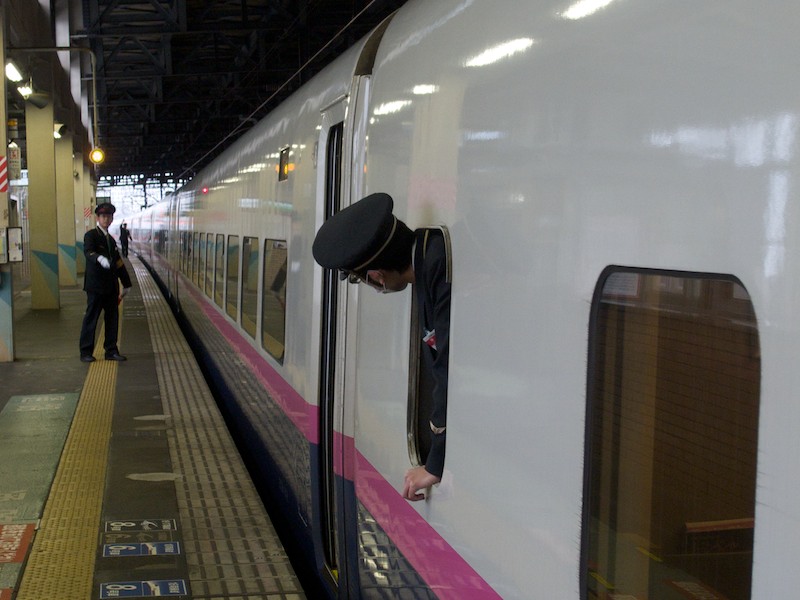
At Kitakami Station the Shinkansen conductor makes sure all passengers clear the train before the train continues to the next stop. The Shinkansen holds a perfect record of passenger safety since the first train ran in 1964.
West of Tokyo a conductor walks the aisles checking tickets. In East Japan the conductor nods politely while reviewing seating data on a digital tablet. When you use your Japanese to ask permission to keep the magazine, he politely replies, "はい" meaning "Yes." You say "ありがとうございます" saying "Thank you" in a very respectful way. He says "どういたしまして" or "It's my pleasure."
After the conductor completes checking passengers, a hostess walks the aisles pushing a food cart. On some trains she carries a food basket. In either case, she sells snacks, beverages and complete lunches at reasonable prices. You can purchase items such as hot tea, hot coffee, cold tea in bottles, bottled water and bento box lunches. The hostess speaks some English. She responds very politely when you attempt to order in Japanese.
When nature calls you can find a toilet location by checking the car map on the seat in front of you. Rising to walk the aisles helps you understand why the conductor occasionally touches a seat for balance. You lightly balance on every third or fourth seat, aiming for empty ones where you can. Using the toilet on a gently moving train at 270kph requires some care, but not as much as using one on an airliner.
Vending machines built into the wall stand near the toilet. They sell beverages such as tea, juice and sometimes beer. The prices match those of convenience stores.
Back in your seat, the ride is so smooth you can sleep. Sometimes you do so without trying. The gentle motion works as a sleep aid. Looking out the window suggests your speed. Close up scenery blurs, while views further away pass by quickly.
Marquee signs at either end of your car announce stops. The announcements always mention brief stops. Believe that word "brief." As the Shinkansen slows, stand, collect your belongings and head for the door at either end of your car. Be polite as others do the same thing. If your stop serves as a terminus, bow to the cleaners waiting to freshen your car.
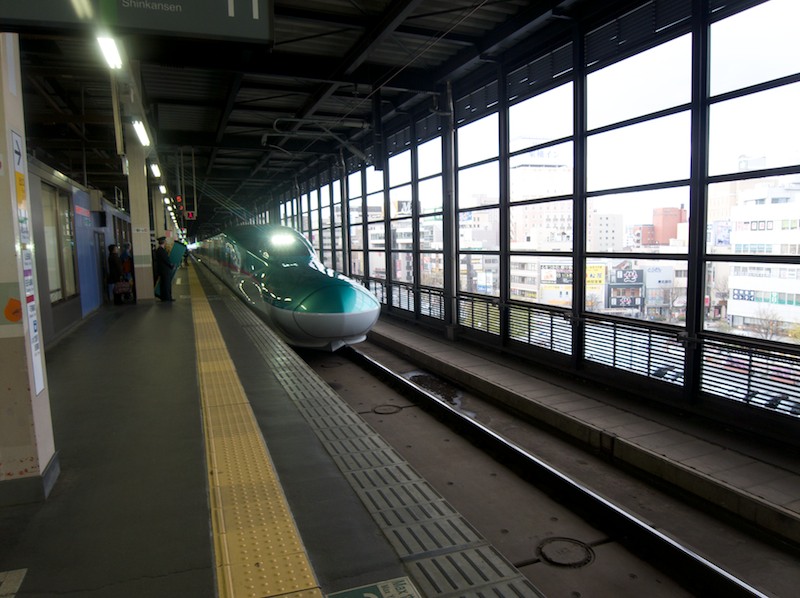
The Hayabusa became the fastest daily operating passenger train in the world on March 2013. While other trains match its top speed of 320 kilometers an hour, the comparatively light weight Shinkansen reaches its maximum speed quickly, giving it higher average and sustained speeds.
Japanese Success Spreads to Europe
Developed from ideas first envisioned in the early 1930s, the Shinkansen went online more three decades later. It provides high capacity travel for a densely populated country. After seeing the success of the Shinkansen, other countries—including Spain, France, Italy and Germany—developed high speed train systems, sometimes modeling their designs on Japanese designs.
What is the Cost?
While visiting friends near Niigata they asked if we planned to take the train through the mountains to Sendai. Upon hearing of our tickets on the Shinkansen—the faster but longer way around—they inquired how we could afford to take it so many places. That is simple. We use a Japan Rail Pass. Available to non-Japanese visiting Japan on their passport—and to Japanese living aboard but visiting home—the JR pass provides unlimited travel to most JR locations for a single price. You can purchase a pass for one, two or three weeks. The pass permits you to travel on the Shinkansen, plus JR cross country trains, local lines, busses and ferries. Again, this is for JR only. Some destinations require you to pay a modest usage fee when JR pays for using private rails.